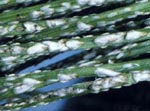Pine Needle Scale
Phenacaspis pinifoliae
Description

Figure 1. Pine Needle
Scale
The pine needle scale appears as a white speck about 1/8 in. in length with a yellow to brown spot at one end. The insect itself is purplish while the eggs and crawlers are both red. Male scales are winged and capable of flight. Female scales are wingless. In winter, the scale will appear gray with purplish eggs underneath the waxy covering. Heavily infested trees have a white or "flocked" appearance. Austrian and mugho pines are favorite hosts of the scale however, Scots and red pines as well as some spruces may be attacked.

Figure 2. Pine Needle
Scale on Scots Pine
Life History
The pine needle scale overwinters as an purplish to reddish egg underneath the parent scale. From 20-30 eggs may overwinter under each female. The eggs hatch in May or June into active crawlers. The crawlers move around on the foliage for a few days, then insert their beak into the leaf tissue, and begin secreting the waxy covering. By late summer they are full grown. A second generation may appear in August. Scales mature and the female deposits eggs which overwinter. There are two generations per year.
Damage
Trees infested with pine needle scale are less vigorous and thrifty and have yellowish to brown needles. The marketability of the tree is reduced particularly those used for Christmas trees. Heavily infested trees may experience needle drop or dieback of branches. Heavy infestations can lead to the death of the plant.
Nonchemical Control
Various parasites and predators have been recorded from the pine needle scale and undoubtedly aid in controlling populations.
Chemical Control
Control of the pine needle scale may be achieved by applying a crawler spray in late May. Dormant oil sprays may also be effective in controlling the overwintering eggs.